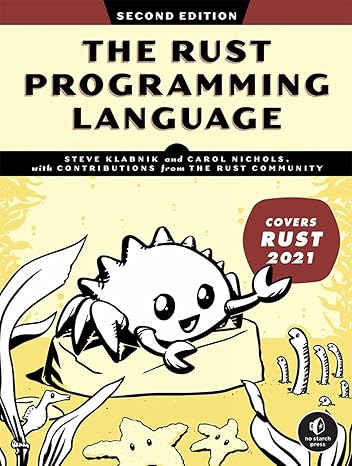My next review is a small departure, it is for The Rust Programming Language by Steve Klabnik and Carol Nichols but rather than buy the physical book I read this interactive version, which has quizzes and embedded, runnable code.
The Rust programming language is the target for my next Rosetta Stone blog post which identifies all the tooling for a language. For Rust these tools (the compiler, formatter, linter, package management and automated documentation) are pretty much all “built-in” so my job will be easy. The challenge in this case has been learning the language since I try to write a little code for the Rosetta Stone posts to demonstrate what I’ve learned.
Rust is a relatively new language, very highly regarded amongst developers and one of only two approved for developing Linux. Its focus is on “safety” and speed. It has been used to make new, highly performant tools for the Python ecosystem, like ruff and uv, which is how I came to know of it.
For a Python programmer Rust does not look alien in the way that Haskell and Lisp do; admittedly it uses curly braces for scoping, is strongly-typed and supports pointers and references which are not features of Python but are common in other languages.
To me it feels like C but with some object-oriented features; the authors talk explicitly about it having features of functional languages including use of the Option value which contains something or nothing, the compiler enforces the handling of nothing. I think I might start using this more explicitly in Python which allows type-hinting to indicate an Option-like value. The other explicitly referenced functional feature is the use of closures, in Python closures are functions defined within functions or anonymous / lambda functions whilst in Rust they seem to be closer to functions passed as arguments to other functions.
Rust makes what seems an odd distinction between functions and macros in its standard library. Macros are identified with an exclamation mark, for example println! As I understand this is because a macro is implemented using code generation at runtime which allows the developer to supply, for example, a variable number of arguments to println! which would not be possible for a function println. Python doesn’t make this distinction and is very permissive in the arguments that a function can take, allowing both position and keyword arguments of variable number.
I was struck by the way that different languages use the same word for different things. For example in Rust a struct is both a data container but can also carry methods in the way that “classes” in other languages do. In Python an enum is a closed list of values but in Rust those values can have user-defined associated values so that an enum for IP address protocols can contain V4 and V6 (as it would in Python) but in addition it can hold an actual IP address associated with each entry in the enumeration.
My understanding is that Rust is considered an object-oriented language by some but not all. In practical terms the only object-oriented feature missing is inheritance although this can be approximated by the use of generics and traits.
Since I have scarcely used pointers and references in 40 years of programming I found these concepts a bit challenging but I have made progress in my understanding through reading this book. Excited by this new found understanding I was then confused by Rust’s ownership model! Ownership and borrowing are the big, unique conceptual features of Rust. The aim of ownership is to rigorously ensure that code is safe – no writing past the end of arrays, or dereferencing null points. It also means that the performance hit of a garbage collector is not required, this task is pretty much entirely handled at compile time by the borrow checker. The strong ownership model makes concurrent programming easier too.
In trying to understand ownership and borrowing I found some useful tools, the best entry point was the BORIS tool by Christian Schott which lists other visualization tools including the Aquascope tool used in this book. I found the first such tool in RustViz which is used in teaching, it needs the user to put annotations into the code rather than working out the annotations itself. I also read this article by Chris Morgan.
As language books go, this one is pretty readable, and I found the built-in quizzes handy, if only to illustrate my ignorance particularly of the ownership and borrowing model. I think for my next technical book I might read Category Theory for Programmers by Bartosz Milewski. I have felt when applying type-hints to Python, and learning Rust and Haskell that I was missing out by not understanding at least the basics of category theory.
I enjoyed this book and the format worked pretty well for me, although I need to find a way of reading online content like this in more comfort. I’m keen to give Rust a go now!


